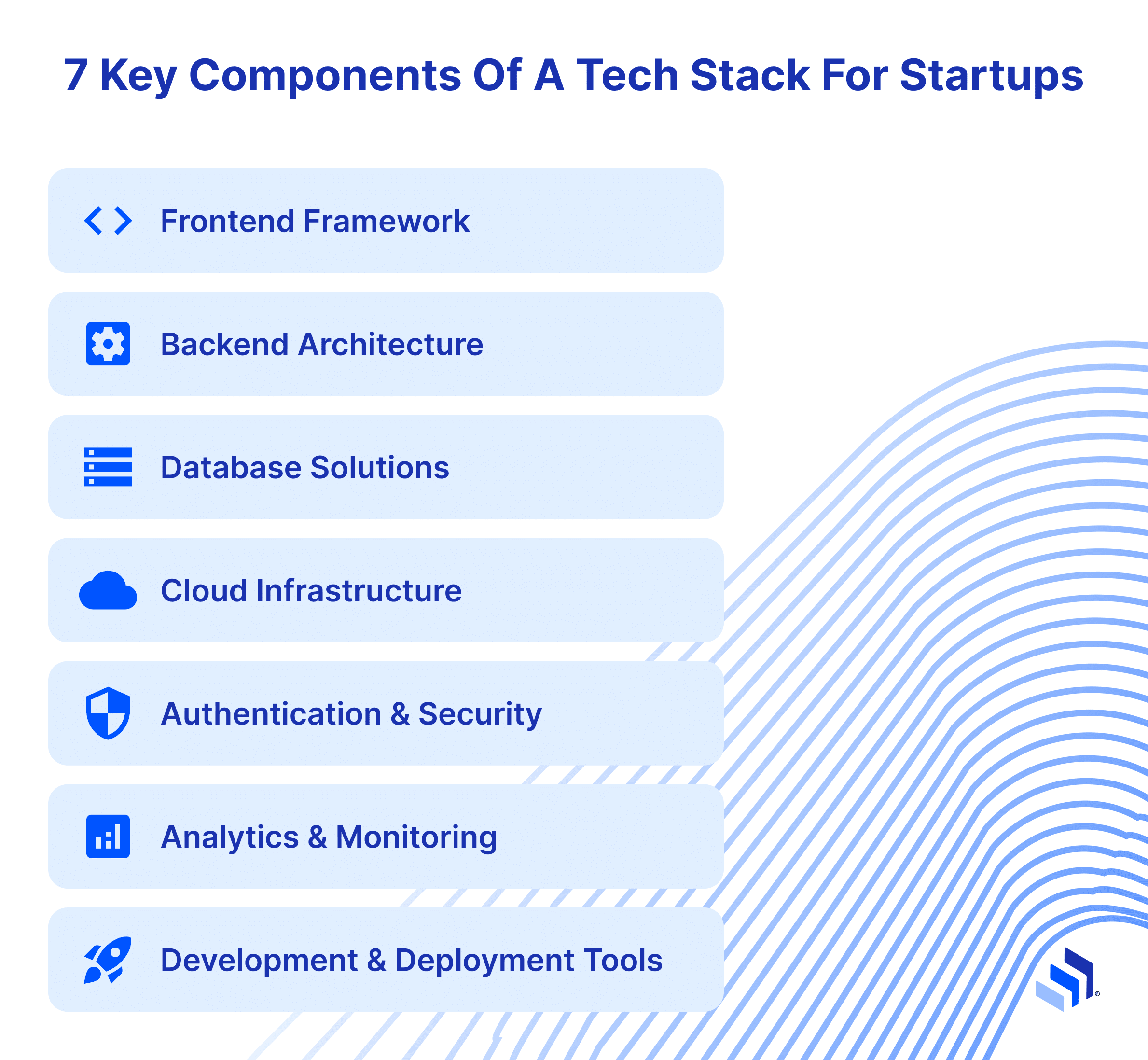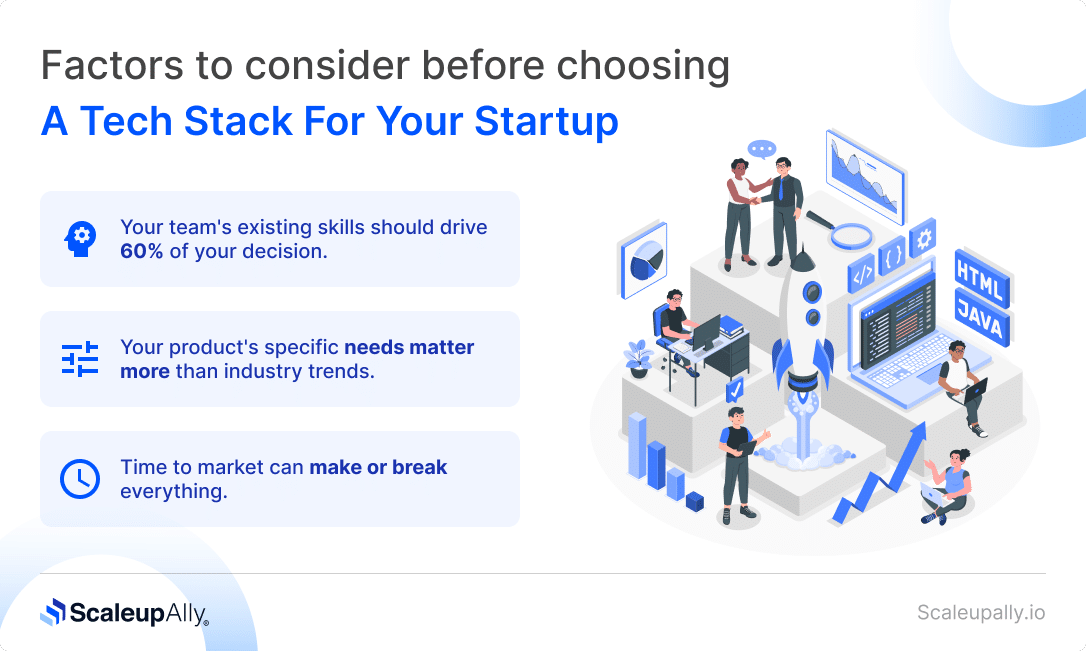
Startup Tech Stack in 2025: How Founders Can Build Scalable, Future-Ready Products
Suprabhat Sen | August 29, 2025 , 16 min read
Table Of Content
A tech stack is the foundation of every tech product. A wrong stack can kill a product faster than even bad marketing could. Hence, choosing a startup’s tech stack shouldn’t be a decision made lightly. A framework that can’t scale alongside your product would have you rebuilding your product all over again. Most founders also make the mistake of choosing a trendy tool. Do so, and you’d be gambling away your startup’s future. Smart founders think differently. They build for tomorrow, and not today’s constraints. Here’s how.
Key Takeaways
- Choose tools your team already knows well. Your developers are more likely to be productive with a stack their familiar with than a trendy framework everytime.
- Start simple and boring, then scale up. Avoid over-engineering for problems you don’t have yet.
- When deciding on which tech stack to stick with, factor in hosting expenses, hiring difficulty, and maintenance overhead.
- Modern startups stitch together services rather than building everything from scratch, so choose tools that play well with others.
- Your tech stack should let developers focus on solving customer problems instead of having difficulties with your choice.
What is a Startup Tech Stack?
- What is a Startup Tech Stack?
- 7 Key Components of a Tech Stack for Startups
- Why Choosing the Right Tech Stack is Crucial for Startups?
- Factors to Consider Before Choosing a Tech Stack for Your Startup
- 3 Best Tech Stack for Startup Businesses to Watch Out For
- Examples of Startup Tech Stacks from Successful Companies
- Top Trends in Tech Stack for Startups
- Common Mistakes Startups Make When Choosing a Tech Stack
- Choosing the Right Tech Stack for Your Startup
- Conclusion
- Frequently Asked Questions
A startup tech stack is a collection of programming languages, frameworks, databases, and tools chosen by a startup to use in building its products.
A stack could include everything from cloud hosting platforms to payment processors. Even though a startup tech stack consists of different components, each piece must work together seamlessly.
Most founders get this wrong. They choose based on personal preference or what’s trending instead of choosing tools that are scalable when you hit product-market fit.
7 Key Components of a Tech Stack for Startups

Every startup’s tech stack needs these seven components that’d scale with you, integrate with other tools, and won’t crumble your product under pressure.
1. Frontend Framework
Your frontend is what makes potential users fall in love with your product or gives them a reason to abandon ship out of frustration. In this category, React dominates. It is flexible and well supported. A good alternative is Vue. For developers who are new to the landscape, Vue offers a gentler learning curve.
We are not asking you to pick these tools. You do not need to participate in the framework wars. Just choose a tool your developers are very confident in, instead of chasing trendy tools by tech influencers on the internet.
2. Backend Architecture
The backend of every app or software handles data processing, business logic, user authentication, and many other tasks. When it comes to choosing a stack for the backend, the same language for both ends means fewer context switches for your team. So, if you are dealing with data-heavy operations, Python and Django go hand in hand. Our tip is to choose something your team won’t have issues debugging. Fancy architectures can wait after you’ve released an MVP and have users using the product.
3. Database Solutions
Your data must live somewhere, and that’s the role a database plays. PostgreSQL scales well, plays nice with everything, and won’t surprise you with weird limitations down the road. MongoDB might tempt you with its flexibility, but that flexibility can become the beginning of problems later when you need complex queries. Start relational unless you have a compelling reason to go document-based.
4. Cloud Infrastructure
AWS still remains the safe choice to date. It offers extensive services, solid documentation, and support when needed. Google Cloud is another option, which offers competitive pricing and excels at data analytics if that’s your thing. Whatever you pick, ensure you take the time to learn their free tier inside and out. Most startups can run lean for months before hitting real infrastructure costs.
5. Authentication & Security
Auth0 or Firebase Authentication save you from security issues when you start authenticating users. User authentication seems simple until you’re dealing with password resets, multi-factor authentication, and compliance requirements. Security isn’t optional anymore. Even simple apps need SSL certificates, proper input validation, and regular dependency updates. Let this be your priority from the very beginning of your product development.
6. Analytics & Monitoring
Google Analytics should cover basic user behavior tracking. If you need deeper product analytics, add Mixpanel or Amplitude. The point of analytics is to understand how users navigate your app. This beats guessing every time. Server monitoring matters too. New Relic or DataDog will alert you when there are downtimes before user emails start flooding in.
7. Development & Deployment Tools
Use Git with GitHub or GitLab to track and manage changes to your source code. In fact, this is not an exception. Set up automated testing and deployment pipelines early, even if they feel like it’s overkill.
For deployment, Vercel makes frontend deployment simple. Docker containers on the other hand might seem like unnecessary complexity now, but they’ll save your sanity when you’re deploying to multiple environments later.
Why Choosing the Right Tech Stack is Crucial for Startups?
Your startup tech stack decision happens once. However, the consequences last for years. One of these consequences is that you’ll rebuild everything when you need to scale. That’s time you don’t have and money you can’t spare. Other reasons why you need to choose the right tech stack include:
1. Speed
When you’re racing to product-market fit, your stack needs to let developers ship features fast. Some technologies feel elegant in theory, but turn simple changes into week-long projects when used in practice.
Ruby on Rails prioritizes developer happiness and rapid iteration over raw performance. This is how it became the darling of early-stage companies. Performance optimization is a luxury problem – the kind you want to have.
2. Hiring becomes infinitely easier with popular tools.
Try finding experienced Erlang developers in your budget range. Now try finding React developers. See the difference? Note that ‘popular’ is not the same as ‘trendy.’
Your tech choices directly impact how quickly you can scale your team. Every esoteric framework choice shrinks your talent pool and inflates your salary requirements. JavaScript might not be perfect, but it’s everywhere.
3. Team expertise trumps anything else
The best tech stack is the one your team can execute with confidence. Your PHP developer might cringe at WordPress, but they can build and deploy features while your team is still configuring microservices. Just know your constraints and work within them.
The right tech stack gives you the best shot at surviving your first two years and thriving beyond them. Think of developers focusing on solving customer problems, features getting shipped predictably, and bugs being caught and fixed quickly.
Factors to Consider Before Choosing a Tech Stack for Your Startup

Every startup thinks their situation is unique. But the thing is, most face identical technical challenges. The only difference is understanding which factors matter most for your specific context. Consider the following factors before jumping on any startup tech stack recommendations.
1. Your team’s existing skills should drive 60% of your decision
Work with what you have instead of forcing your developers to learn Rust because some blog post called it “blazingly fast.” If your lead developer is good at Python, don’t make them suffer through Java just because enterprise companies use it.
Developer productivity in familiar territory beats theoretical performance gains every single time. A happy developer ships faster than a frustrated one who has to deal with unfamiliar syntax.
2. Time to market can make or break everything
Every week you spend debating between PostgreSQL and MongoDB is a week your competitors are shipping features and talking to customers. If boring technology that lets you build fast, then go for it. It doesn’t matter. WordPress powers 40% of the internet – not because it’s elegant, but because it works and people know how to use it. Sometimes boring wins.
3. Your product’s specific needs matter more than industry trends
When building a real-time chat app, WebSocket support is crucial. In the same way, payment processing integration takes priority when creating an e-commerce platform. Developing a data analysis tool? Database query performance trumps everything else. Do you see where we are going? Match your stack to your product. The coolest technology doesn’t automatically solve your customers’ problems.
3 Best Tech Stack for Startup Businesses to Watch Out For
These three stacks have proven themselves in the startup ecosystem. They’ve powered companies from scrappy MVP to IPO without requiring complete rebuilds along the way.
1. MEAN/MERN Stack
Using JavaScript everywhere may sound like a developer’s dream or nightmare, depending on who you ask. MEAN/MERN Stack consists of MongoDB, Express, Angular/React, and Node.js. They create a unified language experience that eliminates context switching.
Advantages:
- Your team develops in one language across the entire application.
- Sharing code between frontend and backend becomes trivial.
- JSON flows naturally between database and user interface.
- The npm ecosystem offers solutions for almost everything you can imagine.
- Hiring gets easier too.
Drawbacks:
- JavaScript’s flexibility becomes a liability as your codebase grows.
- After 100,000 lines, things begin to get complex.
- MongoDB’s schemaless design at a point develops issues when you need complex queries or data consistency
- Performance hits hard when you’re processing heavy computations.
- Node.js excels at I/O operations but struggles with CPU-intensive tasks.
2. LAMP Stack
The LAMP stack consists of Linux, Apache, MySQL, and PHP. These tools built the early internet. Compared to modern alternatives, this stack feels ancient. Ancient doesn’t mean irrelevant, however.
Advantages:
- Rock-solid stability that’s been battle-tested for decades.
- Hosting costs stay low because every provider supports LAMP configurations.
- Documentation exists for every conceivable problem you might encounter.
- The learning curve stays gentle.
- WordPress and similar platforms extend functionality without custom development.
Drawbacks:
- PHP’s reputation precedes it, making top-tier developer recruitment challenging.
- Modern frameworks feel more elegant and maintainable.
- Real-time features require awkward workarounds since PHP wasn’t designed for persistent connections.
- Scaling vertically works fine, but horizontal scaling introduces complexity.
- The stack shows its age when building modern, interactive applications users expect today.
3. Django + PostgreSQL + React
This combination is popular. Python’s readability meets React’s component architecture, and Django provides structure.
Advantages:
- Python attracts talented developers who value code quality.
- Django’s “batteries included” philosophy means less time hunting for third-party solutions.
- PostgreSQL handles complex queries and scales gracefully as data grows.
- The admin interface ships for free, giving non-technical team members immediate access to data management.
- API development feels natural with Django REST framework.
Drawbacks:
- Python’s performance limitations become apparent under heavy load.
- The Global Interpreter Lock restricts true multithreading capabilities.
- Django’s monolithic structure can feel constraining for teams used to microservices flexibility.
- React adds complexity on the frontend, requiring separate deployment pipelines and build processes.
- Full-stack updates demand coordination between multiple moving parts.
Examples of Startup Tech Stacks from Successful Companies
Let’s take a peek behind the curtain at how some of today’s giants built their tech stack.
1. Netflix
Netflix started as a DVD-by-mail service. Their original tech stack was pretty basic stuff. It was mostly Java and Oracle databases running on physical servers. But when they decided to go all-in on streaming around 2007, they faced a problem. How do you serve millions of concurrent video streams without your entire system crashing? Go cloud-native with Amazon Web Services was their answer.
Their tech stack is made up of:
- Backend: Java (Spring Boot), Python, Node.js
- Databases: Cassandra for user data, MySQL for billing, Redis for caching
- Infrastructure: AWS (EC2, S3, CloudFront)
- Streaming: Their own CDN called Open Connect
- Analytics: Apache Kafka, Apache Spark, Elasticsearch
Netflix pioneered many of the practices we now consider standard. Examples include microservices architecture, chaos engineering, auto-scaling based on demand, etc.
Today, Netflix processes over 15 billion hours of content watched monthly.
2. Airbnb
The idea of Airbnb was to convince strangers to sleep in each other’s homes. But the technical challenge was just as complex.
They started simple in 2008:
- Frontend: Basic HTML, CSS, JavaScript
- Backend: Ruby on Rails
- Database: PostgreSQL
- Payments: PayPal integration
Ruby on Rails let them move fast and iterate quickly. But as they grew, they faced the classic startup dilemma: when do you rebuild or optimize?
Today’s Airbnb stack:
- Frontend: React, Redux, JavaScript (moving to TypeScript)
- Backend: Rails (still!), Java, Scala, Go
- Databases: MySQL, PostgreSQL, Redis, Elasticsearch
- Infrastructure: AWS with heavy Kubernetes usage
- Data: Apache Airflow, Spark, Kafka
Top Trends in Tech Stack for Startups
The following trends should be on your finger tips as a top founder:
1. Serverless architecture is eating traditional hosting alive
Functions-as-a-Service platforms like Vercel, Netlify, and AWS Lambda let startups deploy without thinking about infrastructure. This makes sense. Pay only for actual usage instead of keeping servers running 24/7 for traffic that might never come.
But serverless isn’t free. Complex applications sometimes cost more than traditional hosting, and vendor lock-in becomes real when your entire architecture depends on one provider’s services.
2. TypeScript adoption has reached the tipping point
JavaScript’s wild west days are ending as teams realize type safety prevents more bugs than it creates friction. Microsoft’s addition to JavaScript now powers major frameworks and attracts developers who value predictability.
The learning curve still exists though. Legacy JavaScript codebases require gradual migration. Some developers resist the additional syntax overhead, preferring JavaScript’s original flexibility.
3. AI integration
OpenAI’s APIs democratized artificial intelligence for startups that couldn’t afford machine learning teams. Startups are encouraged to use AI to enhance existing features rather than building AI-first products. The AI gold rush creates unrealistic expectations though. Not every problem needs artificial intelligence. Over-reliance on external APIs introduces dependencies and ongoing costs that can spiral quickly.
Common Mistakes Startups Make When Choosing a Tech Stack
When building a startup, every decision feels critical because, frankly, it often is. Here are some of the most common mistakes startups make when choosing a stack:
1. The Shiny Object Syndrome
You heard a Netflix engineer explain their microservices architecture at a tech conference. Then, you observed the audience nodding appreciatively. So you think, “We should definitely use microservices too.”
This is how startups end up with technology stacks that look impressive only on paper.
Do not go down that path. Yes, it might be revolutionary. Or it might be abandoned six months from now when its creators get distracted by the next big thing.
2. The Resume-Driven Development Trap
Developers are human. They want to work with interesting technologies. They want their LinkedIn profiles to sparkle with buzzwords that recruiters love. This creates a subtle but dangerous bias in technology decisions.
In 2017 and 2018, seemingly every startup pitch included blockchain somewhere. Most of them would have been better served by a simple database and a decent backup strategy. Today’s version involves cramming machine learning into products that would work better with basic conditional logic. Not every recommendation engine needs neural networks. Sometimes “users who bought X also bought Y” is perfectly adequate.
Choosing the Right Tech Stack for Your Startup
There’s no perfect tech stack. What exists instead is the right stack for your specific situation, constraints, and goals. Whatever your choice, it comes down to whether they made thoughtful decisions that served their actual needs.
1. Start with Your Business, Not Your Technology
Most founders approach tech stack decisions backwards. They start by evaluating programming languages, then try to figure out how to make their business fit those choices. Flip that around. Define your core requirements first, understand your constraints, then know your non-negotiables.
2. The Framework for Making Decisions
Instead of getting lost in technical specifications, use this systematic approach:
- Map your core use cases: Write down the top five things your application needs to do well
- Identify your biggest risk: What’s most likely to kill your startup? For most early-stage companies, it’s market failure. You’ll die from building something nobody wants long before you die from choosing the wrong database.
- Evaluate your team’s reality: Be honest about your team’s capabilities.
- What technologies do they know well enough?
- What technologies can they hire for within your budget?
- How much time can they realistically spend learning new tools?
- Consider the total ecosystem: No technology choice exists in isolation.
- Your backend choice affects your deployment options.
- Your database choice influences your caching strategy.
- Your frontend framework impacts your mobile development plans.
Conclusion
Choosing the best tech stack for startup success is hard, but make smart decisions that serve your business goals. Start with proven technologies, focus on solving real problems, and scale when you have evidence it’s needed.
Need help defining the right technical strategy for your startup? Our team has guided hundreds of companies through these critical decisions. Contact us today to discuss your requirements and build a technology foundation that grows with your business.
Frequently Asked Questions
Q: Which tech stack is most scalable for startups?
No single stack is universally scalable. PostgreSQL + Node.js/Python handles most startup growth. Focus on proven technologies first.
Q: Should startups use low-code tools for development?
Low-code works for MVPs and non-technical founders testing ideas quickly. However, you’ll hit limitations as you grow. Use for prototypes, but plan migration to custom code when you need unique features or better performance.
Q: What is the best tech stack for an early-stage startup in 2025?
React/Next.js frontend, Node.js or Python backend, PostgreSQL database, and cloud hosting like Vercel or Railway. This combination offers speed, reliability, and abundant developer talent.
Q: What tech stack is best for a SaaS startup?
Most successful SaaS companies use React frontend, Node.js/Python/Ruby backend, PostgreSQL database, with services like Stripe (payments) and Auth0 (authentication).
Related Blogs

Top 20 Emerging Technologies of 2026
Discover the top 20 emerging technologies of 2026. Explore which innovations are driving change across healthcare, finance, manufacturing, and other crucial industries.
ScaleupAlly Team
Dec 16 ,
9 min read

Software Development Timeline: Phases, Duration & Estimation Guide
Understand the software development timeline with phase durations, key factors, hidden delays, and practical methods to estimate project time.
Suprabhat Sen
Nov 29 ,
16 min read

Software Development Cost Estimation Guide: What’s Included & What Affects the Price
Explore software development cost components, major pricing factors, and practical estimation methods to plan your project accurately from start to finish.
Suprabhat Sen
Nov 29 ,
14 min read


